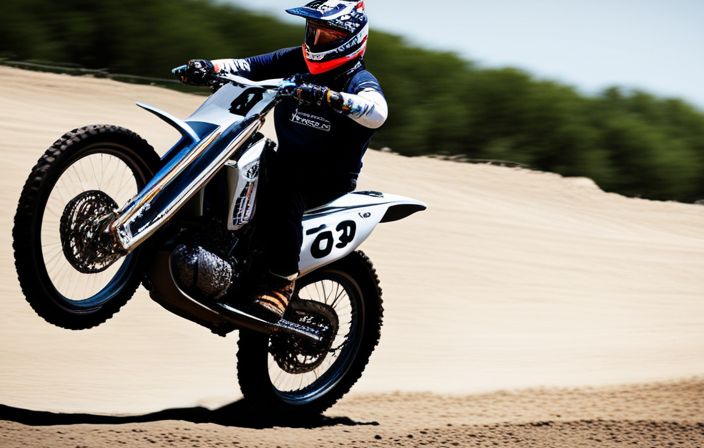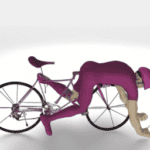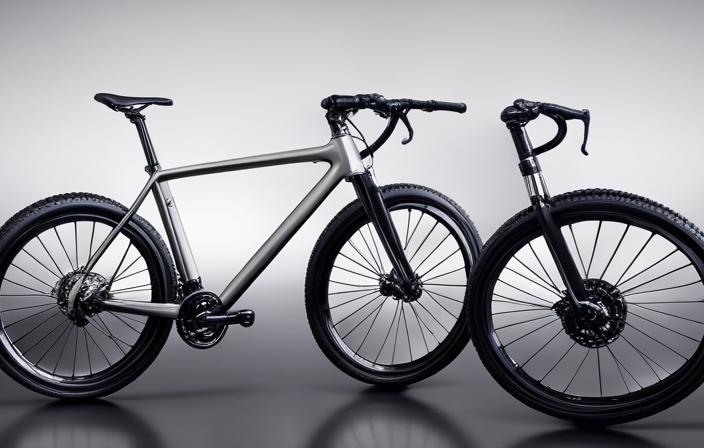How far can you lean your dirt bike on gravel? Have you ever thought about pushing the boundaries of leaning while riding off-road?
In this article, we will explore the factors that affect leaning on gravel, understand the angle of lean, and discuss techniques for maintaining control. Drawing from the experiences of seasoned riders, we will also address common challenges and solutions.
Additionally, we will cover important safety precautions and highlight the significance of protective gear.
Get ready to dive into the technical aspects of leaning on gravel with me!
Key Takeaways
- Reduced traction on loose surface
- Importance of body positioning for stability
- Need for conservative lean angles
- Techniques for improving angle of lean on gravel
Factors that Affect Leaning on Gravel
You can’t lean as much on gravel because the loose surface reduces traction. Understanding the physics of leaning on gravel is crucial to maintaining control and staying safe while riding a dirt bike.
When you lean into a turn on pavement, the tires grip the road, allowing you to achieve higher angles of lean without losing traction. However, when riding on gravel, this grip is diminished due to the loose nature of the surface.
Body positioning plays a vital role in maintaining stability and maximizing traction while leaning on gravel. By shifting your weight towards the inside of the turn, you can increase pressure on the tire that needs more traction. This helps to counteract any loss of grip caused by the unstable surface. Additionally, keeping your body upright and looking ahead will help maintain balance and control throughout the turn.
Understanding the angle of lean is another important aspect when riding on gravel. Due to reduced traction, it’s necessary to be more conservative with your lean angle compared to riding on pavement. Pushing beyond what is feasible may result in loss of control or a slide-out.
Transitioning smoothly into understanding how different factors affect leaning angles will allow us to further explore this topic and enhance our knowledge of dirt bike handling techniques off-road.
Understanding the Angle of Lean
When riding on gravel, it’s important to understand the angle at which you can tilt. The angle of lean is a crucial factor in maintaining control and improving traction on gravel surfaces.
Here are three key techniques to consider when trying to improve your angle of lean on gravel:
-
Body Position: By shifting your weight towards the inside of the turn, you can lower the center of gravity and increase stability. This helps to maintain traction and prevent sliding.
-
Countersteering: Initiating a turn by pushing on the handlebar in the opposite direction allows you to lean into the corner more effectively. It helps maintain control while navigating through gravel.
-
Smooth Throttle Control: Applying smooth and gradual throttle inputs throughout turns prevents sudden acceleration or deceleration, minimizing any loss of traction.
Understanding these angle-of-lean techniques is essential for successfully navigating gravel terrain while maintaining control and grip. By implementing these strategies, riders can confidently tackle corners while maximizing their bike’s performance on loose surfaces.
Transitioning into practicing leaning on gravel, it’s important to put these techniques into action and gain firsthand experience in different scenarios.
Practicing Leaning on Gravel
To improve your control and stability on loose surfaces, it’s important to practice leaning on gravel. When riding a dirt bike on gravel, the surface can be unpredictable and slippery, making it crucial to master the art of leaning. By practicing techniques that allow you to control your balance while leaning, you can enhance your riding skills and navigate through gravel with confidence.
One technique that is effective for practicing leaning on gravel is finding an open area or track where you can safely maneuver your dirt bike. Start by riding at a moderate speed and gradually lean into corners, focusing on maintaining a smooth and controlled motion. This will help you get accustomed to the feeling of leaning on loose surfaces without losing balance or traction.
Another useful technique is adjusting your body position while leaning. Shift your weight towards the inside of the turn and extend your leg outwards for added stability. This will help you maintain control over the bike’s center of gravity and reduce the risk of sliding out.
By practicing these techniques, you’ll develop a better understanding of how much you can lean your dirt bike on gravel while maintaining control. Mastering this skill will greatly enhance your ability to ride confidently in challenging off-road conditions.
As we delve into techniques for maintaining control in the subsequent section, let’s explore how body positioning plays a crucial role in achieving optimal stability while navigating gravel terrain.
Techniques for Maintaining Control
Mastering techniques for maintaining control is essential when navigating through challenging off-road conditions on gravel terrain. Maintaining balance and proper body positioning are key factors in ensuring stability and control while leaning a dirt bike on gravel.
When it comes to maintaining balance, it is crucial to distribute your weight evenly between the front and rear tires. This helps in preventing the bike from sliding out or losing traction on loose gravel. Additionally, keeping your body relaxed yet engaged allows you to make quick adjustments as needed.
Proper body positioning plays a vital role in maintaining control during leans on gravel. Positioning your body towards the inside of the turn helps shift the center of gravity, allowing for better grip and stability. By leaning your upper body slightly forward, you can counterbalance the bike’s tilt.
To provide a visual representation of these ideas, refer to the table below:
| Techniques for Maintaining Control | |
|---|---|
| Maintain Balance | Distribute weight evenly between tires |
| Body Positioning | Lean towards inside of turn; upper body slightly forward |
By mastering these techniques for maintaining control, riders can confidently navigate through challenging off-road conditions on gravel terrain. In the subsequent section about common challenges and solutions, we will explore how to overcome obstacles such as loose rocks and sudden changes in traction without compromising control.
Common Challenges and Solutions
Navigating through gravel terrain poses various challenges that riders must overcome. When leaning on gravel, fear and confidence play a significant role in maintaining control. It is crucial to trust in your skills and the capabilities of your dirt bike. To enhance your confidence, here are four key techniques for body positioning while leaning on gravel:
-
Keep your upper body relaxed but engaged: By maintaining a loose grip on the handlebars and keeping your elbows slightly bent, you allow the bike to move beneath you while still staying connected.
-
Shift your weight towards the outside: Leaning into the turn and shifting your weight towards the outer footpeg helps counterbalance the bike’s lean angle, providing stability.
-
Look ahead and anticipate changes: Keeping your eyes focused on where you want to go allows you to react quickly to any obstacles or changes in traction.
-
Maintain smooth throttle control: Gradually apply throttle throughout the turn to prevent any sudden wheel spin or loss of traction.
By mastering these techniques, you can improve your ability to lean on gravel with confidence and precision.
Transitioning into improving traction on gravel, let’s explore how specific tire choices can enhance stability even further.
Improving Traction on Gravel
When it comes to improving traction on gravel, there are several key points that should be considered.
First, adjusting tire pressure can have a significant impact on performance. By reducing the pressure slightly, you can increase the contact patch and improve grip.
Second, choosing the right tread pattern is crucial. Opting for a tire with deeper lugs or aggressive knobs will provide better traction on loose surfaces like gravel.
Lastly, if the conditions are particularly challenging, considering tire studs or chains can further enhance grip and stability.
Tire Pressure Adjustments
To improve your dirt bike’s performance on gravel, you should adjust the tire pressure. Optimizing tire pressure is crucial for achieving maximum traction and control while cornering on loose surfaces like gravel. By adjusting the tire pressure, you can enhance the contact patch between the tires and the ground, allowing for better grip and stability.
To determine the ideal tire pressure for gravel riding, you need to consider factors such as rider weight, bike weight, and personal preferences. It is generally recommended to lower the tire pressure compared to what you would use on a hard surface. This allows the tires to conform better to uneven terrain, increasing traction.
Here is a table that provides a general guideline for tire pressure adjustments on different types of off-road terrains:
| Terrain | Front Tire Pressure (psi) | Rear Tire Pressure (psi) |
|---|---|---|
| Gravel | 12-15 | 13-16 |
| Sand | 8-10 | 10-14 |
| Mud | 10-12 | 12-15 |
| Hardpack/Loam | 16-20 | 18-22 |
| Rocks/Rough Terrain | 18+ | 20+ |
By optimizing your tire pressure based on these recommendations and mastering cornering techniques, you can significantly improve your dirt bike’s performance on gravel. Moving forward into choosing the right tread pattern…
Choosing the Right Tread Pattern
Choosing the right tread pattern is essential for maximizing your dirt bike’s performance on different types of off-road terrains. The tire tread maintenance plays a vital role in ensuring optimal grip and traction while riding on gravel.
Here are four key factors to consider when choosing the right tread pattern:
-
Knobby Design: A tire with deep, aggressive knobs provides excellent traction on loose surfaces like gravel.
-
Wide Spacing: Tread patterns with wider spacing between knobs help prevent mud from getting stuck, maintaining consistent grip.
-
Side Knobs: Look for tires with prominent side knobs that offer enhanced cornering capabilities on uneven surfaces.
-
Dual Compound Construction: Opt for tires made with a dual compound construction, where a softer rubber compound is used on the edges for better grip during cornering.
By understanding these tire tread features and mastering proper cornering techniques, you can confidently lean your dirt bike into turns and maintain control on gravel surfaces.
Consider tire studs or chains for added traction in icy or extremely loose conditions without compromising safety or maneuverability in your next adventure.
Consider Tire Studs or Chains
When it comes to riding a dirt bike on gravel, choosing the right tread pattern is crucial for optimal performance. However, in certain situations, even the best tread pattern may not provide enough traction. That’s where tire studs or chains come into play.
Tire studs are small metal spikes that can be inserted into the tire tread, providing extra grip on slippery surfaces like gravel. They offer several benefits, including improved acceleration and braking, as well as enhanced stability during cornering.
Installing chains on your dirt bike tires is another option to consider. Chains wrap around the tire and provide additional traction by digging into the loose surface of the gravel. The installation process involves securing the chains tightly around each tire and ensuring they are properly aligned for maximum effectiveness.
By exploring these options such as tire studs or chains, riders can greatly enhance their ability to lean their dirt bikes on gravel confidently and safely without compromising control or stability.
Now let’s delve into how we can learn from experienced riders who have mastered this skill.
Learning from Experienced Riders
Experienced riders can teach you how much you can lean a dirt bike on gravel. Learning from those who have spent countless hours riding on various terrains is invaluable in gaining insight and tips for navigating gravel roads with confidence. When it comes to leaning a dirt bike on gravel, experienced riders emphasize the importance of maintaining control and balance.
Through their experiences with dirt bikes, these seasoned riders have developed techniques that allow them to confidently lean into turns without losing traction or stability. They understand the nuances of gravel and know how to adjust their body positioning and weight distribution accordingly. By observing their riding style and applying their tips, you can improve your own skills on gravel.
To illustrate some of the techniques used by experienced riders, here is a table showcasing different aspects they focus on:
| Aspect | Technique |
|---|---|
| Body Positioning | Lean forward slightly |
| Weight Distribution | Shift weight towards the outside footpeg |
| Throttle Control | Smoothly roll on throttle throughout the turn |
| Braking | Gradually release brakes before entering the turn |
By learning from experienced riders, you can gain valuable insights into how much you can lean a dirt bike on gravel while maintaining control and stability. With this knowledge, you’ll be better equipped to navigate corners confidently. Transitioning into the next section about maintaining your dirt bike for gravel riding, it’s important to keep your machine in optimal condition to ensure safety and performance.
Maintaining your Dirt Bike for Gravel Riding
When it comes to maintaining my dirt bike for gravel riding, there are a few key points that I always make sure to focus on.
First and foremost, regular tire inspections and replacements are essential for ensuring optimal performance and safety.
Secondly, suspension maintenance is crucial in order to maintain proper handling and control while riding on uneven terrain.
Lastly, cleaning and lubricating the chain regularly not only extends its lifespan but also improves overall bike performance.
By paying attention to these aspects of maintenance, I can confidently tackle any gravel trail with ease.
Regular Tire Inspections and Replacements
Regular tire inspections and replacements are important to maintain the safety and performance of your dirt bike. As a rider, it is crucial to regularly check for tire wear and tear.
Worn-out tires can compromise grip on gravel surfaces, leading to potential accidents. To ensure optimal traction, inspect the tread depth and look for any signs of uneven wear or damage. Additionally, consider replacing your tires if they have been used extensively or if there are visible cracks or bulges.
Taking these precautions will not only enhance your riding experience but also reduce the risk of accidents caused by inadequate tire grip.
Moving forward to suspension maintenance, it is essential to keep your bike’s suspension system in top shape for smooth rides on gravel terrains without compromising control.
Suspension Maintenance
Maintaining the suspension on your dirt bike is crucial for a smooth and controlled ride on rough terrains. Proper suspension maintenance involves various tasks, such as angle adjustment and weight distribution.
By adjusting the suspension angles, you can optimize your bike’s handling and stability, allowing it to lean more efficiently while cornering on gravel. This adjustment ensures that your tires have optimal contact with the ground, providing better traction and control.
Weight distribution is another important aspect of suspension maintenance. By distributing your weight properly on the bike, you can minimize bouncing or bottoming out when riding over bumps or uneven surfaces. This helps maintain stability and prevents excessive stress on the suspension components.
In conclusion, ensuring proper angle adjustment and weight distribution in your dirt bike’s suspension is essential for optimal performance on gravel terrains. Now let’s move into the next section about cleaning and lubricating the chain.
Cleaning and Lubricating the Chain
After ensuring that the suspension of your dirt bike is in optimal condition, it’s important to shift our focus towards another crucial aspect of maintenance: cleaning and lubricating the chain. This step is essential for maximizing the longevity and performance of your bike’s drivetrain.
By removing dirt, grime, and old lubricant from the chain, you can prevent premature wear and tear while also ensuring smooth power transmission.
When it comes to cleaning the chain, using a specialized chain cleaner along with a brush will effectively remove any debris trapped between the links. After thoroughly cleaning the chain, applying a high-quality lubricant is vital to reduce friction and prevent rusting. There are various lubricating techniques available, such as drip application or spray-on lubes.
To maintain your chain properly, remember these three key points:
- Clean the chain regularly to remove accumulated dirt.
- Use a suitable brush and specialized cleaner for thorough cleaning.
- Apply a high-quality lubricant after cleaning to ensure optimal performance.
With your dirt bike’s chain well-maintained, it’s time to shift gears (pun intended) into discussing safety precautions and protective gear.
Safety Precautions and Protective Gear
To ensure your safety, it’s important to wear the appropriate protective gear while riding a dirt bike on gravel. Safety should always be the top priority when engaging in any off-road activity.
When it comes to riding a dirt bike on gravel, there are several safety tips that riders should keep in mind.
First and foremost, wearing a helmet is absolutely crucial. It protects your head from potential injuries and can save your life in case of an accident. Additionally, it’s important to wear goggles or a visor to shield your eyes from dust and flying debris.
In addition to protecting your head and eyes, proper gear includes sturdy boots, gloves, knee pads, elbow pads, and body armor. These items help protect against impact injuries and significantly reduce the risk of fractures or abrasions.
Understanding the limits of leaning on gravel is essential for safe riding. Gravel surfaces can be unpredictable due to their loose nature, making it more challenging to maintain balance while cornering at high speeds. Therefore, it’s crucial to approach corners with caution and gradually increase lean angles as you gain confidence in the terrain.
By following these safety tips and wearing the appropriate protective gear, you can enjoy the thrill of riding a dirt bike on gravel while minimizing the risks associated with this exhilarating activity.
Understanding the Limits of Leaning on Gravel
When riding on gravel, it’s important to be aware of the challenges that come with leaning into corners. Gravel poses unique obstacles that can affect the stability and handling of a dirt bike. Understanding the limits of leaning on gravel is crucial for maintaining control and staying safe.
Factors Affecting Stability:
- Surface Conditions: Gravel surfaces are uneven, loose, and unpredictable. The varying sizes and shapes of gravel particles make it difficult for tires to maintain consistent traction.
- Speed: Higher speeds increase the risk of losing control while leaning on gravel. It becomes harder to react quickly and adjust your bike’s trajectory if necessary.
- Bike Setup: Proper suspension settings and tire pressure play a significant role in maintaining stability. Adjustments should be made based on personal preference and the specific conditions you’re riding in.
- Rider Skill Level: Experience and skill level influence how effectively you can navigate corners on gravel. Practice improves your ability to anticipate challenges and adjust your technique accordingly.
Techniques for Cornering:
- Maintain an upright position before entering a corner.
- Gradually lean your bodyweight towards the inside of the turn while keeping the bike as upright as possible.
- Use light throttle control to maintain traction throughout the corner.
- Avoid sudden or aggressive steering inputs that may cause loss of grip.
- Look ahead, scan for potential hazards, and plan your line through the corner.
By understanding these factors affecting stability and employing proper techniques for cornering, you can maximize control over your dirt bike when leaning on gravel surfaces.
Stay vigilant, adapt to changing conditions, and always prioritize safety during off-road adventures!
Frequently Asked Questions
How fast can you lean a dirt bike on gravel?
When it comes to leaning a dirt bike on gravel, controlling speed is crucial.
To maintain control during sharp turns on this challenging surface, it’s essential to master specific techniques.
By carefully modulating the throttle and using your body weight to shift the bike’s balance, you can effectively control your speed while leaning on gravel.
This requires a combination of skill, experience, and precise execution to ensure safety and optimal performance in these demanding conditions.
Can you lean a dirt bike on gravel as much as on pavement?
On gravel surfaces, leaning a dirt bike requires different techniques compared to pavement.
Due to the loose and unpredictable nature of gravel, it’s not advisable to lean as aggressively as on pavement.
However, by adjusting the suspension for gravel surfaces, you can improve stability and control while leaning.
It’s important to maintain a balanced body position and use gradual, controlled movements when leaning on gravel.
This helps minimize the risk of losing traction and maintaining control of the bike.
Are there specific tires that provide better traction on gravel for leaning?
Adjusting tire pressure can indeed affect traction on gravel for leaning. Lowering the tire pressure increases the contact patch, improving grip on loose surfaces like gravel.
However, it’s crucial to find a balance as too low of a pressure can lead to instability and increased risk of punctures.
When it comes to tread design, aggressive patterns with deep lugs offer better traction on gravel by digging into the surface and providing more grip in corners.
What are some common mistakes to avoid when leaning on gravel?
When it comes to leaning on gravel, there are a few common mistakes that riders should avoid.
Firstly, leaning too aggressively can cause the tires to lose traction and result in a skid or a fall.
Secondly, not maintaining proper body positioning can throw off your balance and stability.
To achieve better balance while leaning on gravel, it is important to use techniques such as keeping your weight centered, using smooth and controlled inputs, and gradually increasing lean angle as you gain confidence.
How can I improve my overall balance and stability while leaning on gravel?
To improve my overall balance and stability while leaning on gravel, I need to focus on improving my technique and body positioning.
One key aspect is finding the sweet spot between leaning too much and not enough. By honing my skills, I can find the perfect balance point where I maximize control without compromising safety.
Additionally, maintaining a strong core and proper weight distribution will greatly enhance stability while navigating the unpredictable terrain of gravel.
Conclusion
In conclusion, my fellow dirt bike enthusiasts, the art of leaning on gravel is a delicate dance between skill and sheer bravery.
As we have explored in this article, factors such as traction, body positioning, and maintaining control all play a crucial role in conquering those treacherous gravel roads.
But fear not, for with practice and determination, you too can master the art of leaning on this unforgiving surface.
So strap on your helmet, tighten those grip handles, and prepare to leave a trail of dust behind you as you dominate the gravel terrain like never before!
Ride on!
















